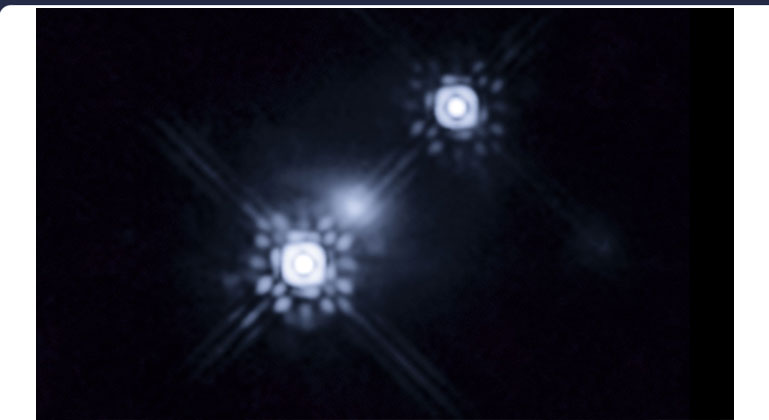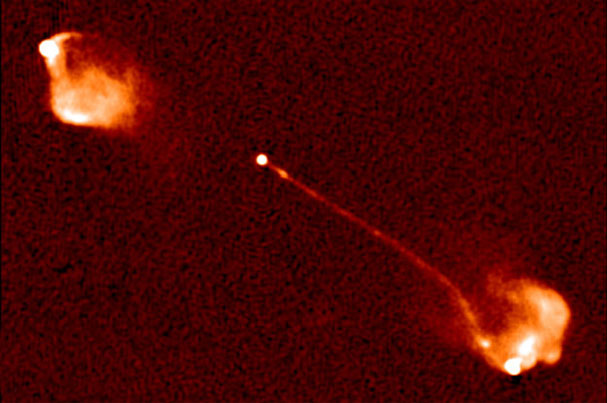




Standing Wave Resonance in Quasar Formations and Alignments
Hubble Directly Observes the Disc Around a Black Hole
by Spacetelescope
November 4, 2011
A team of scientists has used the NASA/ESA Hubble Space Telescope to observe a quasar accretion disc - a brightly glowing disc of matter that is slowly being sucked into its galaxy's central black hole. Their study makes use of a novel technique that uses gravitational lensing to give an immense boost to the power of the telescope. The incredible precision of the method has allowed astronomers to directly measure the disc's size and plot the temperature across different parts of the disc.
An international team of astronomers has used a new technique to study the bright disc of matter surrounding a faraway black hole. Using the NASA/ESA Hubble Space Telescope, combined with the gravitational lensing effect of stars in a distant galaxy [1], the team measured the disc's size and studied the colours (and hence the temperatures) of different parts of the disc. These observations show a level of precision equivalent to spotting individual grains of sand on the surface of the Moon.
While black holes themselves are invisible, the forces they unleash cause some of the brightest phenomena in the Universe. Quasars - short for quasi-stellar objects - are glowing discs of matter that orbit supermassive black holes, heating up and emitting extremely bright radiation as they do so.
"A quasar accretion disc has a typical size of a few light-days, or around 100 billion kilometres across, but they lie billions of light-years away. This means their apparent size when viewed from Earth is so small that we will probably never have a telescope powerful enough to see their structure directly," explains Jose Muņoz, the lead scientist in this study.
Until now, the minute apparent size of quasars has meant that most of our knowledge of their inner structure has been based on theoretical extrapolations, rather than direct observations.
The team therefore used an innovative method to study the quasar: using the stars in an intervening galaxy as a scanning microscope to probe features in the quasar's disc that would otherwise be far too small to see. As these stars move across the light from the quasar, gravitational effects amplify the light from different parts of the quasar, giving detailed colour information for a line that crosses through the accretion disc.
The team observed a group of distant quasars that are gravitationally lensed by the chance alignment of other galaxies in the foreground, producing several images of the quasar.
They spotted subtle differences in colour between the images, and changes in colour over the time the observations were carried out. Part of these colour differences are caused by the properties of dust in the intervening galaxies: the light coming from each one of the lensed images has followed a different path through the galaxy, so that the various colours encapsulate information about the material within the galaxy. Measuring the way and extent to which the dust within the galaxies blocks light (known to astronomers as the extinction law) at such distances is itself an important result in the study.
For one of the quasars they studied, though, there were clear signs that stars in the intervening galaxy were passing through the path of the light from the quasar [2]. Just as the gravitational effect due to the whole intervening galaxy can bend and amplify the quasar's light, so can that of the stars within the intervening galaxy subtly bend and amplify the light from different parts of the accretion disc as they pass through the path of the quasar's light.
By recording the variation in colour, the team were able to reconstruct the colour profile across the accretion disc. This is important because the temperature of an accretion disc increases the closer it is to the black hole, and the colours emitted by the hot matter get bluer the hotter they are. This allowed the team to measure the diameter of the disc of hot matter, and plot how hot it is at different distances from the centre.
They found that the disc is between four and eleven light-days across (approximately 100 to 300 billion kilometres). While this measurement shows large uncertainties, it is still a remarkably accurate measurement for a small object at such a great distance, and the method holds great potential for increased accuracy in the future.
"This result is very relevant because it implies we are now able to obtain observational data on the structure of these systems, rather than relying on theory alone," says Muņoz. "Quasars' physical properties are not yet well understood. This new ability to obtain observational measurements is therefore opening a new window to help understand the nature of these objects."

Baffling Quasar Alignment Hints At Cosmic Strings
by Anil Ananthaswamy for New Scientist
May 9, 2009
Something has made neighbouring quasars in the distant universe point in a similar direction when their orientations ought to be random. Could this be the signature of cosmic strings - gigantic kinks in the fabric of space-time?
In 2005, Damien Hutsemekers at the University of Ličge, Belgium, and colleagues reported an unusual effect in observations of 355 quasars. They found that light from these quasars tended to be polarised, with the electromagnetic oscillations confined to a particular plane that can be described by a polarisation vector. Though there is no obvious reason to think these vectors should be oriented in a special way from one quasar to the next, Hutsemekers's team found that the orientations were not random. If they took any two adjacent quasars, the polarisation vectors pointed in much the same direction.
What's more, as the team looked at ever more distant quasars, they saw this vector rotate by about 30 degrees with every 3.26 billion light years from Earth. The vector turned clockwise when they looked in the direction of the north galactic pole of the Milky Way and anticlockwise looking towards the south pole.
Last year, the team showed that the direction of the polarisation vector is correlated with the axis of rotation of the quasar itself. That means that adjacent quasars tend to have roughly the same orientation - again, not something anyone would have expected to see.
Now, Robert Poltis and Dejan Stojkovic of the State University of New York in Buffalo say they have an explanation. It's all down to events that occurred about 10-12 seconds after the big bang. At that time the universe went through a phase transition, causing the electroweak force to separate into the electromagnetic force and the weak nuclear force. The standard model of particle physics suggests that this would also have resulted in the formation of cosmic strings, which are topological defects in the fabric of space-time and can take the form of giant loops.
Cosmic strings can cause magnetic fields to form along their lengths, says Poltis. The strings are unstable and quickly decay, but the magnetic fields remain and would have become stretched to cosmological scales as the universe expanded.
Poltis and Stojkovic modelled how two giant loops of magnetic field lines could affect galaxies as they formed. A proto-galaxy contains charged particles - electrons and hydrogen ions - which acquire angular momentum from the magnetic field. The net effect is that the proto-galaxy acquires an overall angular momentum, aligning its axis in a certain direction. Two neighbouring proto-galaxies forming in the vicinity of the same magnetic field would end up with their axes pointing in the same direction.
The researchers also showed how the twisting of the magnetic field lines on cosmic scales could cause the axes of quasars to rotate the further out you look.
"This explanation can indeed reproduce our observations quite well, even the possible rotation of the polarisation angle," says Hutsemekers. "Moreover, the possibility that the imprint of strings can be detected through the study of galaxy or quasar orientations is exciting."
Analysis
The latest gravitational lensing techniques have allowed a penetrating view into the nonlinear geometric configuration of the plasma accretion discs that surround black holes, definitively encoded as:
zn+1 = zn2 modulus n
These astounding quasar images very closely resemble the sacred Mayan calendar stone, the sacred Kalachakra mandala images of Tibetan Buddhism, the sacred mandalas of the Sanskrit traditions of India, as well as the sacred sand paintings of indigenous Native American cultures.
This formula has also been identified as fractally encoding the nonlinear structure of standing waves that is clearly seen in the latest quantum stroboscope images of the electron. It is also plainly witnessed within the structures of infrasound standing waves documented by GOES-10 satellite on December 7-8, 2001 - enveloping our entire planet in resoance.
The same formula has appear as a profound mandala formation discovered June 22, 2005 at Lurkley Hill in Lockeridge, England is a rare, but not unprecedented, rendering of a pure math equation. The profound implications of this cosmic formula continue to become recognized with each further glimpse into our expansive Universe.
Quasar surveys compiled by the research team show such a perfect alignment that must be maintained by invisible interstellar magnetic fields. The orientations of all of the quasars within the survey display an octahedral spatial distribution which points directly to the principle of infrasound standing wave resonance as the causal force.
High-resolution imaging of Quasar 3C175 (above) confirms the structural alignment of infrasound standing waves by the Fibonacci order seen along the quasar's linear plasma jets. The three white hot regions of plasma strung out along the linear formation display the Golden Mean, when seen as a line with two segments having the ratio of 1 : 1.618...